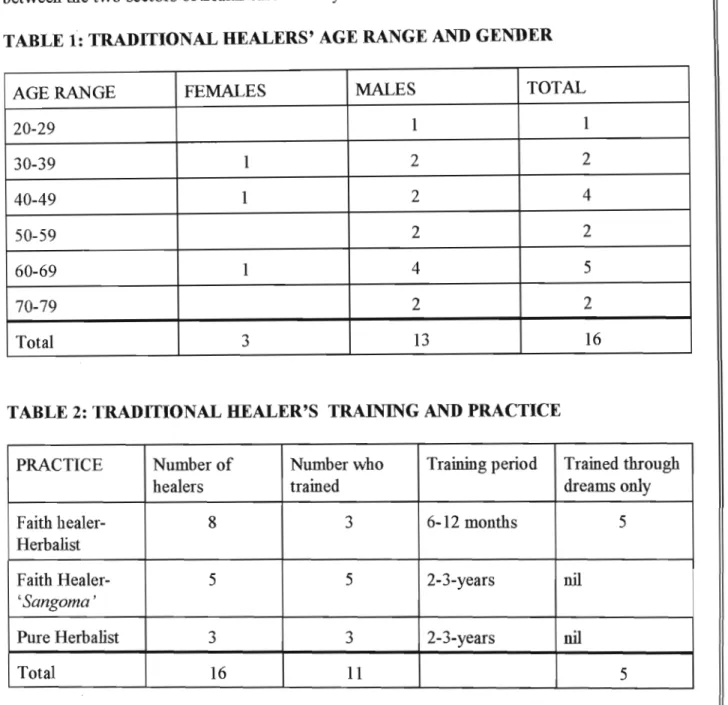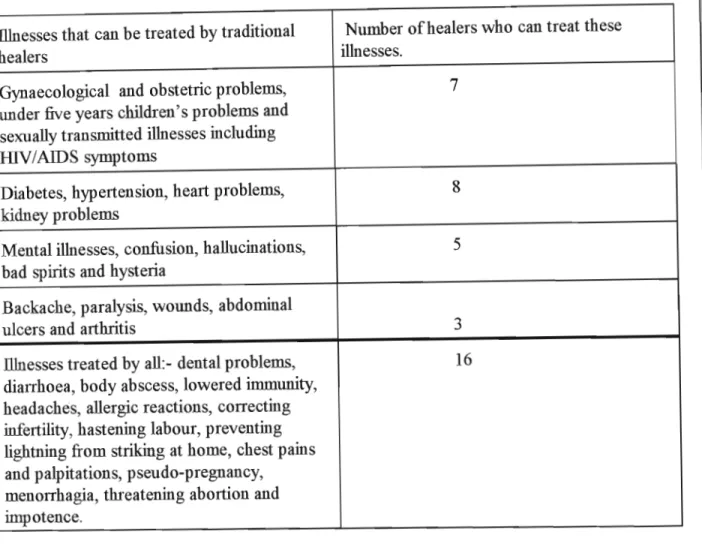Phase two: strategy two, establishing the effectiveness of traditional healers' medicine to control hypertension was established to increase trust between the traditional healers and the western trained health professionals. 3 Incorporation of Western and traditional health in the training of traditional healers and Western trained health professionals.
INTRODUCTION
A REVIEW OF THE WESTERN TRAINED HEALTH CARE WORKERS (doctors and nurses)
They tend to have a similar range of knowledge about the anatomy, physiology and chemical components of the body and the changes that occur and are called diseases. It has been found that they lack knowledge of the anatomy and physiological functioning of the body, but rely mainly on symptoms. Their methods of diagnosis differ from modern experts, as modern experts rely on signs and symptoms and the use of certain techniques to reach a conclusion, while a traditional healer may use mystical means such as throwing bones.
Each system must know the other's capabilities and limitations, but still show respect for the other's system of practice. The traditional healers lack legal bodies, but they have made attempts to have associations like most of the modern health professionals. The ability to work together involves trust and respect not only for each other, but for the work and perspectives that each contributes to the care of the patient.
Although Phipps et al (1995) did not mention the use of traditional healers and traditional medicine, it is known that traditional healers in Africa are part of the culture and also part of the alternative medicine practices that most patients use. It is very important for the biomedical staff to learn more about these traditional practices in order to have a positive collaborative relationship where the good practices can be encouraged for the same purpose: improving patient care or management of the patient.
PROJECTS DEVELOPED IN FOUR COUNTRIES TO INITIATE COLLABORATION
The traditional healers at this site were numerous, including traditional birth attendants (TBAs), herbalists and bone setters. This project was successful because traditional healers and TBAs managed to learn and participate in PHC activities alongside modern healthcare professionals. The program was organized between a hospital called Holy Family and the traditional healers in the village of Techiman.
Traditional healers are highly recognized specialists and should not be relegated to status health workers. Programs involving traditional healers and traditional midwives as health workers in primary health care services were launched in South Africa in the 1980s. The aim of the projects was to involve traditional healers in health promotion at the basic health care level.
It is clear that referrals were expected from the traditional healers and not from the modern healthcare services. 5 Limitations of Traditional Healers in Primary Health Care (PHC) . a) The supply of indigenous biomedical personnel interested in understanding and working with traditional healers appears to be limited.
STUDIES CONDUCTED IN THE AREA OF TRADITIONAL HEALTH SYSTEMS VERSUS WESTERN HEALTH CARE SYSTEM
This study was initiated by the government and as such introduced developments such as the training of traditional healers in certain primary health care projects and the establishment of the traditional healers' association. Others were strongly opposed to collaboration in any way, seeing few positive results in the work of traditional healers. In the pre-wg, approximately 74% reported that they gave the traditional mixture (imbita) to drink and only 55% reported that they gave the traditional mixture in the post-wg. d) The post-wg gave a higher percentage of recommendations to the patient and family attending the clinic, giving oral rehydration salts (ORS), breastfeeding, eating vegetables and bathing regularly than the pre-wg. e) Only 38% of the patients with diarrhea were referred to the clinic in the pre-wg and 60% were referred in the post-wg. F).
A central component of PHC is the commitment to the integration of traditional healers into the general health care system and the facilitation of the employment of traditional healers (as reflected in the WHO's Seventh General Program of Work for the period 1984-1989). Since most of the countries discussed in this study have attempted to integrate traditional healers into primary health care activities, countries could also work to collaborate with traditional healers in the prevention of chronic diseases. Most authors recognized that traditional healers play an important role in the treatment of chronic diseases.
The principles of Action Research also underpin this research, in that the research is conducted to improve the practice of traditional healers and Western healthcare professionals for the benefit of clients. The researcher in this study also learned a lot about the practices of the traditional healers and the. According to the proposal, it was stated that the sample would consist of traditional healers and Western healthcare professionals who deal with chronic diseases.
From Dvokolwako health care centre, seven traditional healers were interviewed and nine in Sithobela area.
DATA COLLECTION
During individual interviews with Western health professionals, it became clear that it was important to develop a descriptive profile of traditional healers. Respondents were western-trained health workers, patients with diabetes and hypertension, and traditional healers. They contacted the chief, who then organized traditional healers through his runners to attend a meeting with the researcher.
The purpose of the study and the phases of the study were fully explained to the traditional healers. Only seven (7) traditional healers were interviewed and by then the researcher reached data saturation. A traditional healer who is also a member of the Community Health Care Center Committee assisted the researcher by offering his son as a guide to find traditional healers.
For the start-up of the traditional healer office, the researcher used open discussions with .. the traditional healers, leaders of their organizations and the Ministry of Health and Social Affairs. A lot of information was collected from the clients, traditional healers and western health workers.
DATA ANALYSIS
Creswell (1994) explained that in qualitative research, several simultaneous activities capture the researcher's attention. A computer specialist was brought in to assist the researcher in continuing the data analysis using such a program to ensure that proper data analysis occurred. This did not happen because the data were such that the researcher could use manual analysis.
The methodology of this study was clearly presented and the researcher followed the planned data collection steps. The data was critically analyzed by the researcher to enhance the credibility of the different phases of the study. In addition to carefully describing each phase of the study, the researcher used quotes from participants to illustrate the categories developed or themes identified.
An expert qualitative researcher was used to clearly monitor the decisions made by the researcher within each phase of the study. According to Denzin and Lincoln (1994), a qualitative study must deal with the researcher's experience and qualifications in relation to credibility.
ETHICAL CONSIDERATIONS
The practice of the traditional healers was such that they were classified as Sangoma herbalist, faith healer sangoma herbalist or pure herbalist. The traditional healers said that the sugar will be added to reduce heart palpitations and destroy the poison caused by the sugar in the diabetes. Cooperation with traditional healers in dealing with diabetes:- they all stated that they do not cooperate with traditional healers.
There seems to be no cooperation between the traditional healers and Western health care. Half of the clients said they felt improvement when they started using the hospital medication along with the traditional healers' herbal mixtures. e). Consultation with traditional healers: All clients said that they consulted traditional healers and were given herbal mixtures.
Traditional healers' and Western health care workers' definitions of diabetes and hypertension appear to be similar. Western health care workers stated that traditional healers were referring patients to them, but that the collaboration was informative.

DEFINING THE PROBLEM OF COLLABORATION WITH REGARD TO THE MANAGEMENT OF DIABETES AND HYPERTENSION
Traditional healers observed ethical practices that Western health care workers did not understand. Most of the clients, traditional healers and western health care workers stated that the Ministry of Health should do something about cooperation. There were similarities in how Western-trained health care workers, clients, and traditional healers defined collaboration.
Traditional healers and Western health care workers should be allowed to follow up with clients they have referred. This will enable the traditional healers and Western health care workers to discuss problems they encounter during the referral process. Many traditional healers began to ask questions that were well answered by most Western trained health care workers.
Clients need to be educated by both traditional healers and Western-trained health professionals to make informed decisions. This would ensure that Western-trained health workers would be free to refer patients to traditional healers.
ESTABLISHING THE TRADITIONAL HEALERS' CONSTITUTION, OFFICE UNDER THE MINISTRY OF HEALTH AND SOCIAL WELFARE AND THE
This followed the late King Sobhuza's request for the Ministry of Health to organize traditional healers. Attempts were made to create a traditional healer's office, but the administrators in the Ministry of Health called them 'Witch Doctors'. The leader of this organization was very positive about this development of the traditional healer's constitution.
One of the problems they faced with the Ministry of Health was the issue of HIV I AIDS, as they felt that the Ministry was withholding information from traditional healers. They started discussing the matters of the organization of traditional healers and urging new members to join. The head of the organization of traditional healers dominated the discussions so that no one had a chance to speak.
The leaders have done things without the knowledge of the majority of traditional healers. For example, a traditional healer stated that traditional healers had no organization in 1975.
